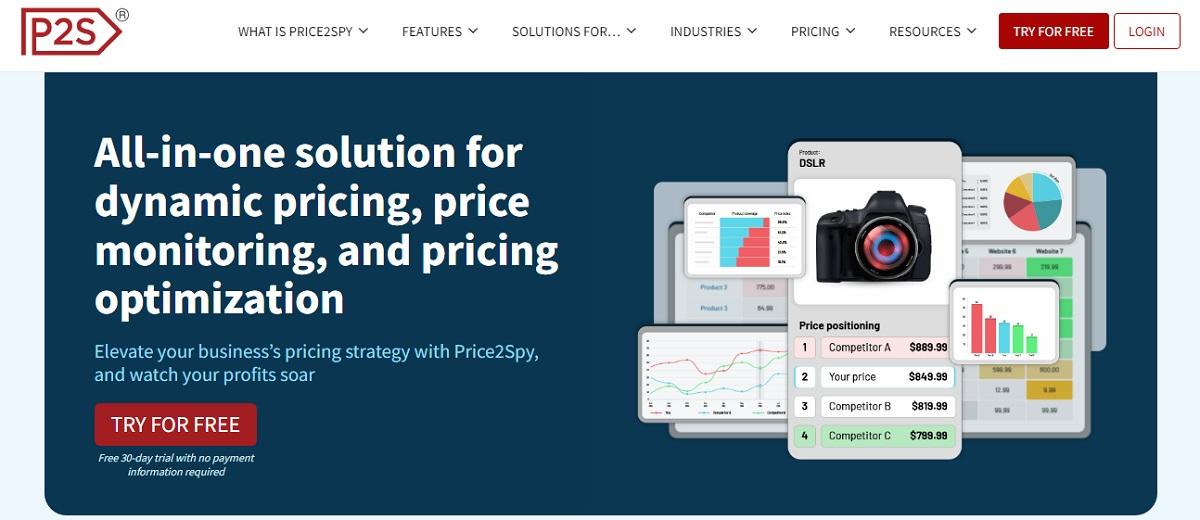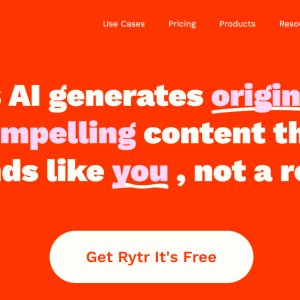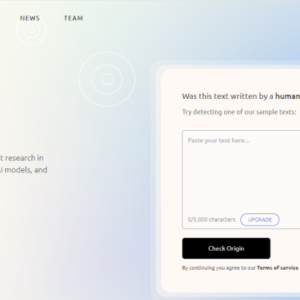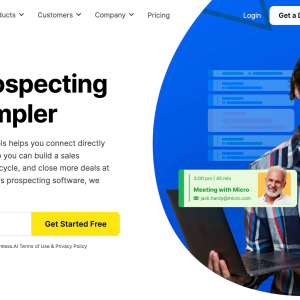In today’s highly competitive business landscape, staying ahead of the game requires businesses to have a deep understanding of their market and competitors. One crucial aspect of this understanding is having accurate and up-to-date pricing information. Price intelligence tools have become invaluable assets for businesses looking to optimize their pricing strategies and drive growth. In this article, we will explore five excellent price intelligence tools that can help energize your business growth today. From monitoring competitor prices to analyzing market trends, these tools offer comprehensive solutions that can give you a competitive edge and propel your business towards success.
- How AI-Generated Content Boosted Website Traffic to 750K/mo
- 9 ChatGPT Success Stories to Highlight What You Can Do!
- Murf AI Review: Voiceover Technology that Delivers on its Promise
- Stay Ahead of the Curve: The 10 Best AI Podcasts to Tune Into Today
- AI in Business: How We Use Artificial Intelligence at Our Agencies
Boost your business strategy with our guide on the five best price intelligence tools!
You are viewing: 5 Excellent Price Intelligence Tools to Help Energize Your Business Growth Today
Discover powerful software to decode product pricing mysteries. And give your business a competitive edge.
These tools can track market trends in real-time and could be the key to unlocking business success.
Our List of Price Intelligence (Monitoring) Tools
Price monitoring tools will inject new energy into your strategies – no more guesswork!
And so, we’ve gathered a selection of top-tier price intelligence tools to revolutionize your approach to pricing strategies.
This software offers everything from real-time insights to precision analytics. So be sure to consider each and how they may help your specific needs!
1. Price2Spy: Best Overall Tool
Price2Spy is a comprehensive price monitoring and analysis tool for professionals and e-commerce businesses. Its strengths lie in its comprehensive reporting, alert systems, and user-friendly nature.

The versatile tool gives you the ability to track competitor strategies across various e-commerce platforms and marketplaces. And it also allows for monitoring of your own price changes.
Pros
- Detailed Reporting and Analytics. Comprehensive reporting for in-depth analysis of data.
- Alerts for price changes. Sends notifications when prices change, helping users stay updated.
- Customizable pricing rules. Allows users to set their own rules to meet specific business needs.
- User-friendly interface. Easy to use and navigate.
- Unlimited competitors/site monitoring. Enables monitoring of unlimited competitors and sites.
- Dynamic and repricing. Assists in adjusting prices dynamically based on market conditions.
- Bot-aware site monitoring. Protects against bot detection when monitoring competitor sites.
- MAP features. Supports monitoring of Minimum Advertised Price compliance.
- Mobile-friendly. Accessible on mobile devices, enhancing convenience.
Cons
- You may need help integrating with specific e-commerce platforms or tools.
- The basic plan might restrict the number of items that can be monitored.
Fees:
- 30-day free trial
- Paid Plans. Starting at $26.95 per month.
2. Prisync: Great Competitor Tracking Specialist
Prisync is a competitor price tracking and pricing software. It is designed for e-commerce businesses of all sizes globally.

Prisync offers real-time insights through features like:
- Product matching
- Price comparison
- Change alerts
- Historical data analysis.
The software automatically tracks competitor prices and stock availabilities. The information is presented through its web dashboard, email alerts, API, and other reports.
Prisync provides:
- Frequent price updates
- Advanced filtering
- Stock monitoring.
Pros
- Comprehensive tracking. It efficiently tracks competitor strategies across multiple channels.
- Automated pricing rules. Enables the automated setting of rules to adapt quickly to market changes.
- E-commerce integrations. Offers integrations with popular e-commerce platforms for seamless functionality.
- Customizable analytics. Provides customizable reports and analytics for deep market insights.
Cons
- Initial setup can be challenging, needing more time or technical knowledge.
- There may be delays in troubleshooting and support response times.
You can start using Prisync with a 14-day free trial. Paid plans begin at $99 monthly.
The software offers different tiers of features for various business needs and sizes, including:
- Professional
- Premium
- Platinum.
3. Skuuudle: Highly Accurate & Customizable
Skuuudle is an e-commerce price monitoring tool. It is used by companies like Primark, Groupon, and Citibank.

Skuuudle is a business solution for comprehensive price tracking and market analysis. And its automated analytics make it a valuable tool to achieve competitive advantage.
It offers a range of features, including:
- Price and discount tracking
- Product attributes scraping
- Product description scraping
- Customized reporting.
The tool enables businesses to track competitors’:
- Product availability
- Exact product names
- Product variations.
It is particularly adept at providing detailed insights into trends.
Skuuudle stands out for its automated analytics – crucial for strategic retail decision-making.
Pros
- Accurate pricing intelligence. Offers reliable and precise pricing decision-making.
- Customizable reporting. Tailors reports to meet specific business needs.
- Wide range of integrations. Compatible with various platforms, enhancing its utility.
- Consulting services. Provides additional support and expert advice for users.
Cons
- It may need time and effort to understand and use all features fully.
- There are some limitations in its integration capabilities.
Fees:
- Free Trial. Available for initial assessment of the tool.
- Customizable plans. Plans are tailored to fit business sizes and specific requirements.
4. Dealavo
Dealavo is an AI-powered price tracking and optimization tool for online stores and manufacturers. It operates internationally in over 30 countries.

Dealavo offers:
- Detailed and aggregated competitor price monitoring
- Promotions
- Stock availability
- Dynamic pricing based on market data
- ROAS Booster for optimizing CPC ad campaigns.
Additionally, Dealavo integrates with major e-commerce platforms such as Magento and WooCommerce.
It uses machine learning for data mapping. And it is validated by a Quality Assurance Team. Dealavo offers a high SLA score of up to 99%.
The tool includes:
- A dedicated Customer Success Manager
- Custom integrations
- MAP/MSRP
- Promotion tracking
- Price war detection
- Dynamic pricing.
See more : What’s The Best AI Music Generator? Your Complete Guide With 7 Great Options
Dealavo is compatible with various e-commerce platforms and ERP systems.
Pros
- Global market coverage. Tracks prices and competitors in over 30 countries.
- Advanced features. It offers a range of sophisticated tools, including dynamic pricing and ROAS booster.
- High accuracy and reliability. Employs machine learning algorithms and manual verification.
- Integration capabilities. Compatible with major e-commerce platforms and ERP systems.
- Customizable solutions. Provides options for custom integrations and system customization.
Cons
- Pricing transparency. Specific details need consultation.
- Complexity. The range of features and international coverage might present a learning curve for new users.
- Limited trial period. A seven-day free trial may be short for comprehensive evaluation.
5. Competera
Competera is a pricing optimization and competitive intelligence platform. It aims to enhance business strategies.

Competera uses advanced data analytics and machine learning algorithms. It gathers and analyzes data from many sources.
It offers:
- Real-time market insights
- Trends
- Competitor strategies.
Its offerings are divided into three categories:
- Competitor data for real-time insights
- Dynamic pricing for automated market-based price changes
- Price optimization using various strategies
Competera is scalable regardless of product and category volumes.
Pros
- Automated pricing processes. Streamlines adjustments based on the market.
- Customizable strategies. Allows for tailored strategies to suit specific business needs.
- Extensive integration options. Compatible with various systems and platforms.
- Industry versatility. Applicable to a wide range of business sectors.
Cons
- Complex setup and learning. Implementing and mastering the platform can be challenging.
- High cost. This may be a barrier for smaller businesses.
- Opaque pricing structure. Details are not disclosed.
Competera offers a free trial for initial evaluation. After this, businesses need to contact sales for a customized plan.

What is Price Intelligence Software & Why is it Important?
Price intelligence is also known as competitive price monitoring. It refers to systems that collect and analyze data on competitor pricing strategies and market trends. This is then used to inform a company’s decisions.
It involves using modern data mining techniques to gain accurate and real-time information. This can help companies optimize their pricing and purchasing strategies.
Competitive price monitoring helps retailers stay relevant and adapt to market changes.
Companies can use price monitoring software to track and analyze prices across their industry. This allows them to make informed decisions about:
- Pricing strategy, including optimizing prices and promotions
- Gaining a competitive edge
- Identifying new revenue opportunities
- Improving profitability
- Providing a better service to their customers.

Additionally, price intelligence tools help companies set optimal prices based on customer demand. This allows them to differentiate themselves from competitors. It also helps to drive more sales and match customer expectations more accurately.
This practice is crucial in the fast-paced, competitive, and ever-evolving retail environment.
How Does it Work?
Price intelligence software uses advanced algorithms and data-gathering techniques. It collects and analyzes information from various sources.

Here’s a breakdown of how it typically functions.
Data Collection
The software scans the internet to gather information from various sources. This can include:
- Competitors’ websites
- Online marketplaces
- Physical store data available online.
It uses web scraping techniques and API integrations to collect this data.
Data Cleansing and Normalization
The gathered data is then cleaned and normalized. The process involves:
- Removing duplicates
- Correcting errors
- Converting the information into a standardized format.
Analysis
The pricing intelligence software analyzes the data using various algorithms. This analysis can include:
- Comparing prices of similar products
- Monitoring price changes over time
- Identifying pricing trends
- Understanding market conditions.
Competitive pricing intelligence
The software can provide insights into how a business’s prices compare to its competitors. This includes competitive intelligence. It identifies products where the company is priced higher or lower than the market average.

Price Optimization
Some price monitoring software goes a step further by recommending strategies. Based on the data analysis, price optimization can be performed. Price optimization will suggest optimal prices to achieve a competitive advantage. This will lead to:
- Increased sales volume
- Increased profit margin.
Reporting and Alerts
Users receive reports and alerts based on the analysis. These can include:
- Real-time notifications of price changes
- Pricing trends reports
- Recommendations for price adjustments.
Integration with Business Systems
Often, this software can integrate with other business systems like:
- Inventory management
- e-commerce platforms
- ERP (Enterprise resource planning) systems.

This allows for automated adjustments and a more cohesive business strategy.
With these steps, price intelligence software helps businesses stay competitive by making informed pricing decisions.
Benefits of Using Price Intelligence Tools
Implementing pricing intelligence can provide many benefits to businesses.

Greater customer loyalty
These tools can help businesses offer competitive prices and better deals. This helps them to attract and retain customers, increasing customer loyalty.
Potential revenue growth
A good pricing strategy can increase revenue through higher prices or better pricing models.
See more : Best AI Review Generator? 5 Tools You Need To Know About
Improved visibility into the market
Pricing intelligence enables businesses to monitor their competitors’ prices and market trends. This insight assists companies in making strategic, well-informed decisions.

Reduced price-related risks
Having real-time access to market data allows businesses to make informed pricing decisions. It prepares businesses to adapt swiftly to changes in the market environment.
Optimized pricing strategies
Pricing intelligence can help businesses identify new revenue and adopt competitive strategies.
Competitive edge
Pricing intelligence can provide valuable insights into:
- Competitors’ stock-outs
- Promotions
- Assortment planning.
This allows businesses to improve their strategy and outperform competitors.
Inventory management
Using competitive pricing and tracking market trends helps businesses manage inventory stock levels.

Dynamic repricing
Dynamic pricing software enables businesses to implement active repricing strategies. This helps them adapt to market changes and maintain competitive prices.
Time and cost savings
Pricing intelligence services automate the process of collecting and analyzing information. This automation saves businesses significant time and effort. Companies can then focus more on strategic planning and improving their business performance.
Key Features to Look for in a Price Intelligence Tool
Here are the key features to look for.
Fast and Automated Data Collection
The tool should offer:
- Fast and efficient search
- Automated collection
- Daily tracking of prices by product, range, and competitor.
Comprehensive Competitor Monitoring
It should provide the ability to track and also monitor the online prices of competitors. This must include big eCommerce sites and storing all relevant information in one place.
Insightful Analysis and Reporting
The tool should offer:
- Programmed analysis
- Insight into price changes
- Automatic alerts of retailer price changes and promotions.

User-friendly Interface
A user-friendly interface is essential for incorporating fresh, high-quality, complex data.
Accurate and Extensive Product Coverage
A price monitoring tool should ensure:
- Exact product matching
- Extensive product coverage
- High data update frequency to provide up-to-date and actionable insights.
Competitive Pricing Strategy Support
It should improve the visibility of competitor activity. And achieve a competitive pricing strategy.
Data Segmentation and Export
The tool should allow the segmentation of competitors’ data into detailed charts. It should also offer the ability to save and export reports in various formats for easy analysis.
How to Integrate a Price Intelligence Tool with Your Existing Systems
Integrating a tool with your existing systems can be achieved by following these steps.
Evaluate your business goals
Determine your objectives for using such a tool, for example:
- Improving your pricing strategy
- Monitoring competitors
- Gaining market insights.

Choose the right tool
Select a pricing intelligence tool that meets your needs and integrates with your existing systems.
Consider factors like:
- Data collection
- Analysis
- Reporting capabilities
- Ease of use
- Integration options.
Understand the tool’s capabilities
Familiarize yourself with the features and functionalities of the chosen tool, such as:
- Data collection methods
- Analysis tools
- Reporting options.
Integrate with CRM and ERP systems
Ensure the software can be integrated with your CRM and ERP systems.

Look for seamless integration software, such as:
- API
- Cloud
- Plug-in options.
Customize the tool
Customize the pricing intelligence tool to suit your specific needs, for example:
- Targeting competitors
- Monitoring particular product ranges.
Monitor and optimize your pricing process
Continuously monitor and optimize your process using the insights gained from the tool.
This may involve adjusting your pricing strategy based on:
- Market trends
- Customer preferences
- Competitor activities.

Analyze and report data
Leverage the data collected by the monitoring tool to analyze:
- Market dynamics
- Competitor strategies
- Customer preferences.
Generate reports and insights to inform decisions and improve your business strategy.
Price Intelligence Tools in Closing
The five price intelligence tools discussed here can elevate your business strategy.
The software is available for you to try, and many offer free trials. So why not experience these tools firsthand and see how they can contribute to the efficiency and profitability of your business?
It’ll mark the next step in optimizing your pricing and gaining a competitive advantage!
Your business will gain valuable insights and a strategic edge in today’s fast market.
Read more about AI tools in our article on artificial intelligence in retail business. You might also be interested in learning about all-in-one marketing platforms to help grow your business.
That concludes the article: 5 Excellent Price Intelligence Tools to Help Energize Your Business Growth Today
I hope this article has provided you with valuable knowledge. If you find it useful, feel free to leave a comment and recommend our website!
Click here to read other interesting articles: AI
Source: wubeedu.com
#Excellent #Price #Intelligence #Tools #Energize #Business #Growth #Today
Source: https://wubeedu.com
Category: AI





